What is Mendel’s Law of Dominance?
Mendel’s Law of Dominance is one of the foundational principles of genetics, formulated by Gregor Mendel through his experiments with pea plants. It asserts that when two homozygous organisms, each possessing contrasting traits for a specific character, are crossed, only one of the traits will appear in the first generation. This observed trait is known as the dominant character.
Mendel’s law indicates that traits are controlled by specific units, now referred to as genes, which exist in pairs within an organism. Each pair consists of two alleles—one inherited from each parent. When the two alleles differ (heterozygous), one allele typically overshadows the other. The dominant allele manifests in the organism’s appearance, while the recessive allele remains hidden.
Even though the recessive trait does not appear in the first generation, it is still passed down to offspring. For the recessive trait to be expressed, both alleles must be recessive, creating a homozygous condition for that trait. This explains why recessive traits can skip generations but still reemerge in later offspring.
Fertilization is the process that brings together the two alleles, with one coming from the egg and the other from the sperm. Mendel’s Law of Dominance strictly refers to the genetic (genotypic) makeup of an organism, rather than its physical appearance (phenotype).
While Mendel’s Law of Dominance helped clarify the inheritance of traits, modern genetics has since expanded on his work. It’s now understood that not all traits follow simple dominant-recessive patterns, and other forms of inheritance, such as incomplete dominance and codominance, also exist.
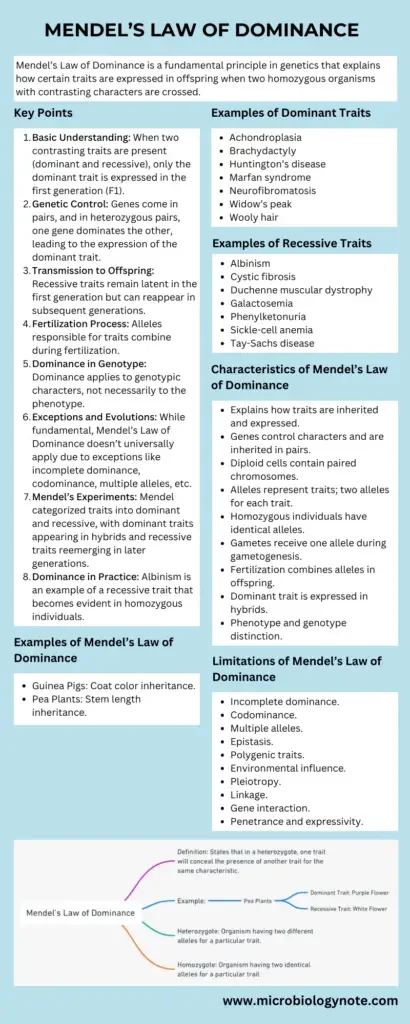
Download Mendel’s Law of Dominance Infograph
Definition of Mendel’s Law of Dominance
Mendel’s Law of Dominance states that when two organisms with contrasting traits are crossed, the trait that appears in the first generation is the dominant one, while the recessive trait is masked but can still be passed to future generations.
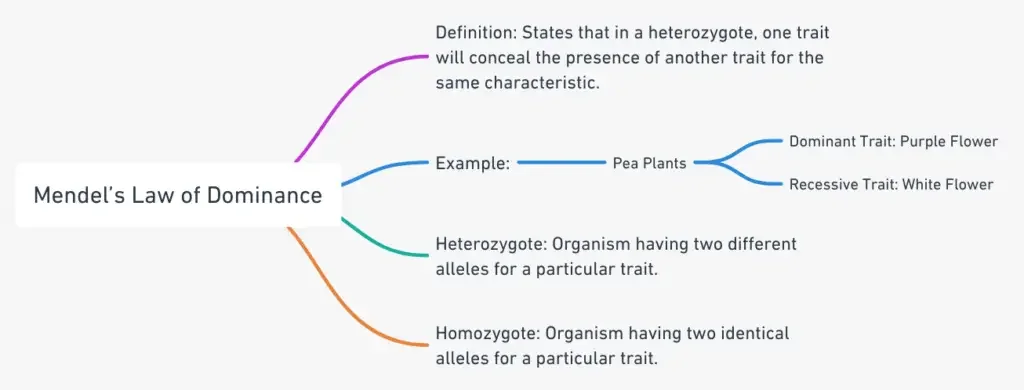
Mendel’s Law of Dominance Characteristics
Mendel’s Law of Dominance can be broken down into several key characteristics that explain how traits are inherited from one generation to the next. These characteristics offer a detailed understanding of how dominant and recessive alleles interact to express certain traits in offspring.
- Unit of Inheritance
- Genes are the basic units of inheritance. These are passed from parents to offspring through gametes (sperm and egg). Each gene controls specific traits in the organism.
- Alleles in Pairs
- In diploid organisms, genes exist in pairs on chromosomes. Each chromosome in the pair comes from one parent. For each trait, there are two alleles—one from the mother and one from the father.
- Homozygous and Heterozygous Combinations
- Homozygous individuals possess two identical alleles for a trait (e.g., TT for tallness in pea plants). Heterozygous individuals have two different alleles for the same trait (e.g., Tt).
- Separation of Alleles
- During gametogenesis (the formation of gametes), homologous chromosomes—and their respective alleles—are separated. Each gamete receives only one allele for a given trait.
- Dominant and Recessive Traits
- When contrasting alleles come together in a heterozygous condition (Tt), only the dominant allele (T) expresses itself in the organism’s phenotype, while the recessive allele (t) remains hidden.
- Expression of Traits
- The offspring of a cross between two homozygous individuals, one with a dominant trait (TT) and one with a recessive trait (tt), will all exhibit the dominant trait. This is because the dominant allele masks the presence of the recessive allele in the first generation.
- Transmission of Recessive Traits
- Though recessive traits (e.g., dwarfness in pea plants) do not appear in the first generation of a heterozygous cross, they are still carried by the offspring. These traits can reappear in subsequent generations if two recessive alleles are inherited (tt).
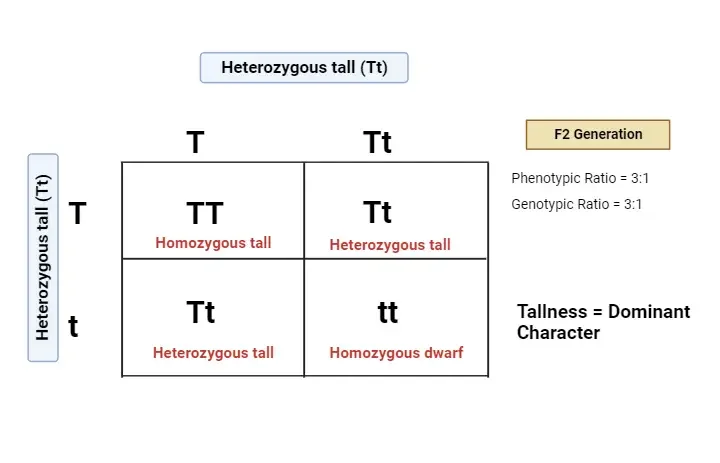
Examples of Mendel’s Law of Dominance
- Guinea Pigs
- In an experiment involving guinea pigs, a cross between a homozygous black guinea pig and a homozygous white guinea pig demonstrates Mendel’s Law of Dominance. All offspring in the first generation (F1) exhibit the black color, indicating that black is the dominant trait, while white is recessive.
- When these black F1 hybrids are crossed, they produce offspring in a ratio of 3:1—three black guinea pigs to one white. The black color dominates whenever present, while the white color only appears in the homozygous recessive condition (ww), reaffirming the dominance of black in this inheritance pattern.
- Pea Plants
- One of the most famous examples of Mendel’s Law of Dominance comes from Mendel’s original experiments with pea plants. He examined traits such as stem length, seed color, and cotyledon shape. In the case of stem length, the two contrasting traits were tallness (TT) and dwarfness (tt).
- When a homozygous tall pea plant (TT) is crossed with a homozygous dwarf pea plant (tt), all the F1 generation plants are tall, showing that tallness is the dominant trait. When these F1 hybrids (Tt) are crossed, the offspring exhibit a 3:1 ratio—three tall plants for every one dwarf plant. Here, tallness is dominant and always expressed in the presence of a tall allele, while dwarfness only appears when both alleles are recessive (tt).
- Human Eye Color
- In humans, the inheritance of eye color can also illustrate Mendel’s Law of Dominance. Brown eye color (B) is typically dominant over blue eye color (b). When a person with homozygous brown eyes (BB) is crossed with someone who has homozygous blue eyes (bb), all the offspring in the F1 generation will have brown eyes.
- However, when two heterozygous individuals (Bb) with brown eyes are crossed, the offspring show a 3:1 phenotypic ratio—three with brown eyes and one with blue eyes. Blue eyes only appear when both alleles for the recessive trait are present (bb).
- Flower Color in Snapdragon Plants
- Snapdragon plants provide a classic example of incomplete dominance, but their standard red and white flower colors can also serve as an example of Mendel’s Law of Dominance when considering dominant and recessive traits. In a cross between a homozygous red-flowered plant (RR) and a homozygous white-flowered plant (rr), the F1 generation consists of all red flowers, demonstrating the dominance of the red allele.
- In the F2 generation, however, the offspring follow a 3:1 ratio of red to white flowers, showing that red dominates over white, which only appears when both alleles are recessive (rr).
- Human Hair Type
- In humans, curly hair (C) is dominant over straight hair (c). If a person with homozygous curly hair (CC) mates with someone with homozygous straight hair (cc), all their offspring will have curly hair.
- When two heterozygous curly-haired individuals (Cc) are crossed, the offspring display a 3:1 ratio: three individuals with curly hair and one with straight hair. Straight hair only manifests when both alleles for the recessive trait (cc) are inherited.
- Seed Color in Pea Plants
- Another example from Mendel’s pea plant experiments involves seed color. Yellow seeds (Y) are dominant over green seeds (y). When a homozygous yellow-seeded plant (YY) is crossed with a homozygous green-seeded plant (yy), all offspring in the F1 generation have yellow seeds.
- In the F2 generation, a 3:1 ratio emerges—three plants with yellow seeds to one with green seeds. The green seed trait only appears when both alleles are recessive (yy), further demonstrating Mendel’s Law of Dominance.
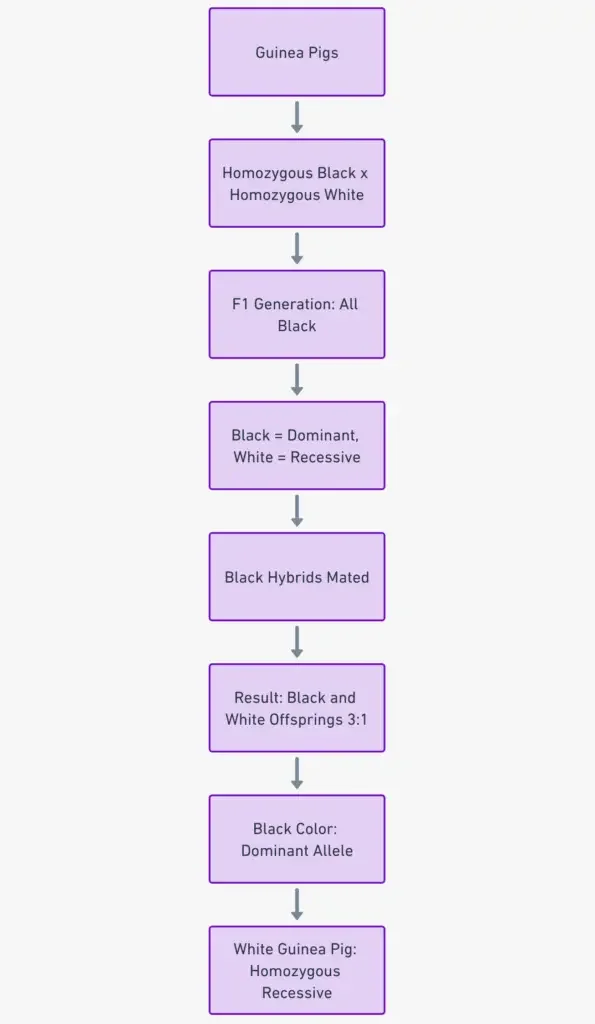
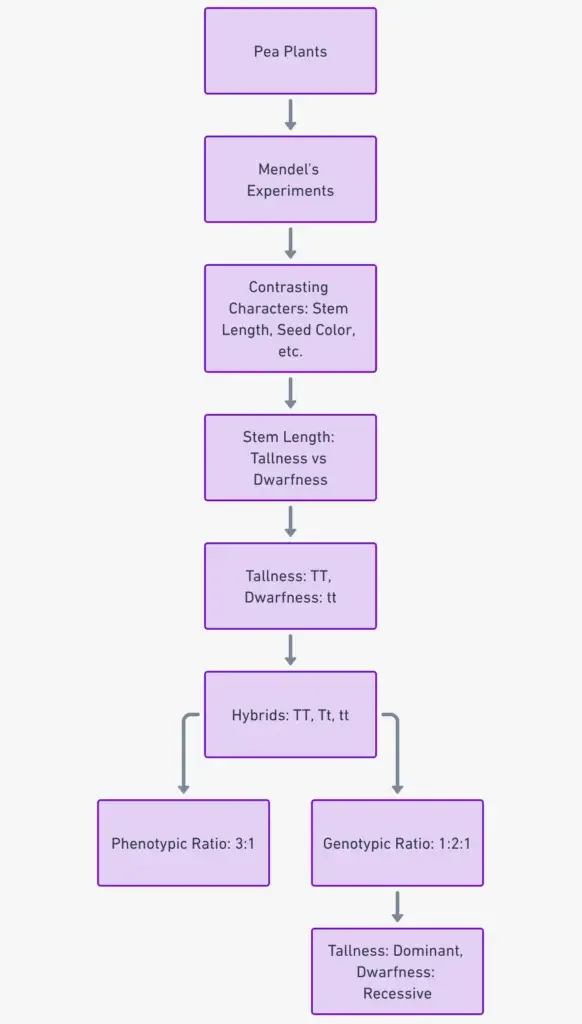
Limitations of Mendel’s Law of Dominance
- Limited Applicability to Diploid Organisms
- Mendel’s Law of Dominance applies primarily to diploid organisms, meaning those with two sets of chromosomes. Therefore, it cannot be generalized to organisms with different chromosomal structures, such as haploid organisms or those that reproduce asexually.
- Not Universal Across All Organisms
- The law is restricted to organisms that reproduce sexually. It does not hold in species that undergo asexual reproduction, where genetic variation and dominance do not play a role in the same way.
- Not the Only Mode of Inheritance
- Although Mendel initially viewed dominance as the standard mode of inheritance, later research revealed other inheritance patterns, such as blending inheritance, where offspring show traits that are a mixture of parental characteristics.
- Exceptions in Certain Traits
- Dominance does not apply to all contrasting characters. Some traits do not follow a simple dominant-recessive pattern, indicating that Mendel’s law cannot explain all inheritance phenomena.
- Incomplete Dominance and Co-Dominance
- In certain cases, inheritance is governed by incomplete dominance or co-dominance, where neither allele completely dominates the other. For example, in incomplete dominance, the phenotype is an intermediate blend, while in co-dominance, both alleles are fully expressed. These patterns contradict the assumptions of Mendel’s Law of Dominance.
- Polygenic Inheritance
- Mendel’s law also does not apply to polygenic traits, where multiple genes influence a single trait. Traits like human height or skin color, controlled by multiple genes, do not follow the simple dominant-recessive inheritance outlined by Mendel.
- Epistasis
- Another limitation is epistasis, where one gene can mask or alter the expression of another gene at a different locus. This phenomenon cannot be explained by Mendel’s Law of Dominance, which assumes independent gene function.
Examples of dominant and recessive traits in humans
Human traits are determined by the combination of genes inherited from our parents. These genes can carry different forms, known as alleles, which can be dominant or recessive. Dominant traits are expressed when at least one copy of the dominant allele is present, while recessive traits are only expressed when two copies of the recessive allele are present.
Dominant Traits:
- Achondroplasia: This is a type of dwarfism caused by a dominant allele. Individuals with one copy of the dominant allele will exhibit the trait, resulting in short stature and disproportionate limbs.
- Albinism: Albinism is a condition where individuals lack pigment in their skin, hair, and eyes due to a faulty allele. Even a single copy of the dominant allele can lead to albinism.
- Brachydactyly: People with this trait have shorter fingers and toes due to a dominant allele. It results in a characteristic appearance of the hands and feet.
- Huntington’s Disease: This is a neurodegenerative disorder caused by a dominant allele. It leads to motor dysfunction, cognitive decline, and emotional disturbances later in life.
- Marfan Syndrome: Marfan syndrome is caused by a dominant allele and affects the connective tissues in the body. It can result in tall stature, long limbs, and various cardiovascular issues.
- Widow’s Peak: A dominant allele for a widow’s peak hairline creates a V-shaped point in the middle of the forehead.
- Wooly Hair: This trait is characterized by tightly curled hair due to a dominant allele. Individuals with one copy of the allele will have this hair texture.
Recessive Traits:
- Cystic Fibrosis: This is a life-threatening genetic disorder caused by two copies of a recessive allele. It affects the respiratory and digestive systems, leading to mucus buildup and related complications.
- Duchenne Muscular Dystrophy: A recessive allele responsible for this disorder leads to progressive muscle weakening and loss. It predominantly affects males.
- Galactosemia: Individuals with two recessive alleles for galactosemia are unable to metabolize galactose, a sugar present in milk. This can lead to severe health problems if not managed.
- Neurofibromatosis: A person needs two copies of the recessive allele to develop this disorder characterized by tumors growing on nerve tissue.
- Phenylketonuria (PKU): PKU is caused by two recessive alleles and affects the body’s ability to process the amino acid phenylalanine. If untreated, it can lead to intellectual disabilities.
- Sickle-Cell Anemia: This recessive trait affects hemoglobin, causing red blood cells to become misshapen. It provides some resistance to malaria when inherited in one copy (known as sickle-cell trait).
- Tay-Sachs Disease: Individuals with two recessive alleles for Tay-Sachs disease lack an enzyme necessary to break down certain fatty substances in the brain and nervous system, leading to severe neurological deterioration.
In summary, dominant and recessive traits in humans are determined by the presence of specific alleles. Dominant traits are expressed even when just one copy of the allele is present, while recessive traits require both copies to be present for expression. These traits contribute to the rich diversity seen in the human population and play a vital role in genetics and inheritance.
| Dominant Traits | Recessive Traits |
|---|---|
| Achondroplasia | Cystic Fibrosis |
| Albinism | Duchenne Muscular Dystrophy |
| Brachydactyly | Galactosemia |
| Huntington’s Disease | Neurofibromatosis |
| Marfan Syndrome | Phenylketonuria (PKU) |
| Widow’s Peak | Sickle-Cell Anemia |
| Wooly Hair | Tay-Sachs Disease |
Facts on Mendel’s Law of Dominance
- Pioneer of Genetics: Gregor Mendel, an Austrian monk, is known as the “Father of Genetics.” He conducted his experiments on pea plants in the mid-19th century and formulated the laws of inheritance.
- Basic Principle: The Law of Dominance states that in a cross of parents that are pure for contrasting traits, only one form of the trait will appear in the next generation. This dominant trait will mask the presence of the other, recessive trait.
- Pea Plant Experiments: Mendel chose pea plants for his experiments because they have easily distinguishable characteristics, such as tall or short height, yellow or green seeds, and so on.
- Homozygous and Heterozygous: If an individual has two identical alleles for a trait, they are homozygous for that trait. If they have two different alleles, they are heterozygous. A heterozygous individual will express the dominant trait.
- Recessive Traits: Recessive traits are not expressed in the presence of a dominant allele. They only appear when an individual has two copies of the recessive allele (homozygous recessive).
- Genotypic and Phenotypic Ratios: When Mendel crossed two heterozygous individuals (for a particular trait), the resulting offspring had a genotypic ratio of 1:2:1 (homozygous dominant: heterozygous: homozygous recessive) and a phenotypic ratio of 3:1 (dominant trait: recessive trait).
- Not Always Simple: While Mendel’s experiments with pea plants showed clear dominant and recessive traits, many traits in nature are influenced by multiple genes and can have incomplete dominance or codominance.
- Mendel’s Three Laws: The Law of Dominance is just one of Mendel’s three laws of inheritance. The other two are the Law of Segregation and the Law of Independent Assortment.
- Rediscovery: Mendel’s work was largely ignored during his lifetime. It was only around the turn of the 20th century that scientists rediscovered his research and recognized its significance.
- Modern Genetics: Mendel’s laws laid the groundwork for the field of genetics. Today, with advances in DNA sequencing and molecular biology, scientists have a much deeper understanding of inheritance, but Mendel’s principles still hold true for many simple genetic traits.
Latest Research Work on Mendel’s Law of Dominance
- Evolution of Mendelian dominance in gene regulatory networks associated with phenotypic robustness
- Authors: Kenji Okubo, Kunihiko Kaneko
- Publication Year: 2021
- Abstract: Mendelian inheritance is a fundamental law of genetics. This research discusses the evolution of dominance in gene regulatory networks, especially in cases beyond the classical one-to-one mapping. The study reveals that dominance can be achieved even in complex gene regulatory networks and is associated with increased robustness against genome mixing during meiosis.
- Link to the paper
- Important heterosis on hybridization
- Publication Year: 2021
- Abstract: This paper discusses the genetic understanding of heterosis following the rediscovery of Mendel’s laws in 1900. It delves into the genetic explanations for the increased heterozygosity in hybrids and the dominance hypothesis, which suggests that hybrids are stronger because recessive genes from one parent are usually concealed by dominant genes from the other.
- Link to the paper
- The genetic architecture of the maize progenitor, teosinte, and how it was altered during maize domestication
- Authors: Qiuyue Chen, Luis Fernando Samayoa, Chin Jian Yang, and others.
- Publication Year: 2020
- Abstract: This research studies the genetics of domestication, especially focusing on maize and its ancestor, teosinte. The study observed a reduced number of QTL in maize compared to teosinte and a higher dominance in maize, likely due to the selective removal of certain variants during domestication.
- Link to the paper
Mendel’s Law of Dominance Worksheet
- Definitions: a. Dominant Allele: _________________ b. Recessive Allele: _________________
- True or False: a. A dominant allele will always be expressed in the phenotype. ( ) b. Recessive alleles can only be expressed when two copies are present. ( ) c. If an organism has two dominant alleles for a trait, it will not express that trait. ( )
- Fill in the Blanks: a. In pea plants, the allele for tall plants (T) is _________ over the allele for short plants (t). b. An organism with the genotype Tt will have a _________ phenotype. c. An organism with the genotype tt will have a _________ phenotype.
- Match the Genotype to the Phenotype: a. TT – _________ b. Tt – _________ c. tt – _________Options: i. Tall ii. Short
- Scenario: In a population of flowers, the red color (R) is dominant over the white color (r).a. What is the phenotype of a flower with the genotype Rr? _________________ b. What is the phenotype of a flower with the genotype rr? _________________ c. If two Rr flowers are crossed, what is the probability that their offspring will be white? _________________
Answers:
- a. An allele that expresses itself even when only one copy is present. b. An allele that can only express itself when two copies are present.
- a. True b. True c. False
- a. Dominant b. Tall c. Short
- a. Tall b. Tall c. Short
- a. Red b. White c. 25%
FAQ
What is Mendel’s Law of Dominance?
Mendel’s Law of Dominance states that in a hybrid organism, one allele of a pair may mask the expression of the other allele. The allele that masks the expression of the other is termed the dominant allele, while the one that gets masked is termed the recessive allele.
Who discovered the Law of Dominance?
The Law of Dominance was discovered by Gregor Mendel, an Austrian monk, during his experiments with pea plants in the mid-19th century.
How did Mendel determine this law?
Mendel conducted breeding experiments with pea plants, crossing plants with contrasting traits (e.g., tall vs. short). He observed that the first generation (F1) always showed the trait of one parent, leading him to conclude the concept of dominance.
What is a dominant allele?
A dominant allele is one that expresses itself in the phenotype, even if only one copy is present in the genotype.
What is a recessive allele?
A recessive allele is one that can only express itself in the phenotype when two copies are present in the genotype.
Can a recessive trait appear in the first generation (F1) of a hybrid cross?
No, in a typical hybrid cross between two pure-breeding organisms (homozygous dominant and homozygous recessive), the recessive trait does not appear in the F1 generation. It can, however, reappear in the F2 generation.
What is a genotype?
A genotype refers to the genetic makeup of an organism, specifically the combination of alleles for a particular trait.
What is a phenotype?
A phenotype refers to the observable physical or biochemical characteristics of an organism, as determined by the genotype and environmental factors.
How can one determine if an organism with a dominant phenotype is homozygous dominant or heterozygous?
A test cross can be performed. The organism in question is crossed with an organism that is homozygous recessive. If any offspring display the recessive phenotype, the original organism is heterozygous.
Are all traits determined by complete dominance?
No, while Mendel’s experiments showcased complete dominance, other patterns of inheritance exist, such as incomplete dominance and codominance.
References
- Mendelian inheritance in man: A catalog of human genes and genetic disorders.
- Authors: V. A. McKusick
- Publication Year: 1998
- Abstract: This paper provides a comprehensive catalog of human genes and genetic disorders, emphasizing the Mendelian inheritance patterns.
- Link to the paper
- Mendel’s legacy: The origin of classical genetics.
- Authors: J. Sapp
- Publication Year: 2002
- Abstract: This paper delves into the origins of classical genetics, tracing back to Mendel’s foundational work.
- Link to the paper
- Mendel in the kitchen: A scientist’s view of genetically modified foods.
- Authors: N. Fedoroff, N. Brown
- Publication Year: 2004
- Abstract: The authors provide a scientific perspective on genetically modified foods, referencing Mendel’s principles.
- Link to the paper
- Mendel’s principles of heredity.
- Authors: W. Bateson
- Publication Year: 1909
- Abstract: A classic work that discusses Mendel’s principles of heredity in detail.
- Link to the paper
- Mendel’s dwarf.
- Authors: S. Mawer
- Publication Year: 1997
- Abstract: This paper explores the implications of Mendel’s work on dwarfism and its genetic basis.
- Link to the paper
- Mendel’s opposition to evolution and to Darwin.
- Authors: R. Olby
- Publication Year: 1966
- Abstract: The paper discusses Mendel’s stance on evolution and his disagreements with Darwin’s theories.
- Link to the paper
- Mendel’s laws of inheritance and Watson-Crick DNA model: Connecting the dots.
- Authors: J. D. Watson, F. H. Crick
- Publication Year: 2003
- Abstract: The authors connect Mendel’s laws with the modern understanding of DNA, drawing parallels between the two.
- Link to the paper
- Mendel’s experiments: A reinterpretation.
- Authors: R. C. Olby
- Publication Year: 1966
- Abstract: This paper offers a fresh perspective on Mendel’s experiments, reinterpreting his findings in light of modern genetics.
- Link to the paper
- Mendel and modern genetics: The legacy for today.
- Authors: E. R. Sears
- Publication Year: 1963
- Abstract: The author discusses the lasting impact of Mendel’s work on modern genetics and its implications for contemporary research.
- Link to the paper
- Mendel’s theory of heredity.
- Authors: H. Iltis
- Publication Year: 1932
- Abstract: This paper delves into Mendel’s theory of heredity, discussing its foundational principles and implications.
- Link to the paper
- https://unacademy.com/content/neet-ug/study-material/biology/law-of-dominance/
- https://www.biologyonline.com/dictionary/law-of-dominance
- https://rwu.pressbooks.pub/bio103/chapter/mendelian-genetics/
- Text Highlighting: Select any text in the post content to highlight it
- Text Annotation: Select text and add comments with annotations
- Comment Management: Edit or delete your own comments
- Highlight Management: Remove your own highlights
How to use: Simply select any text in the post content above, and you'll see annotation options. Login here or create an account to get started.